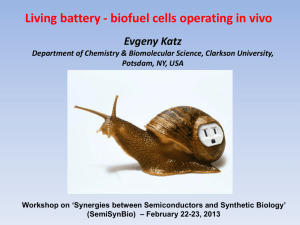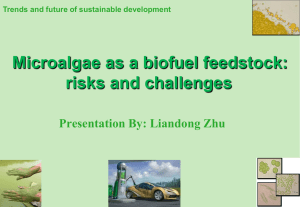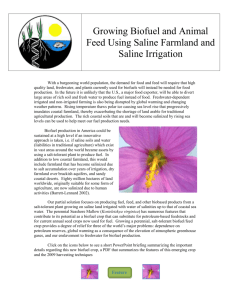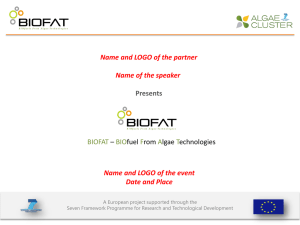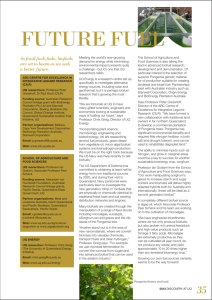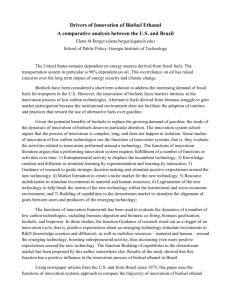A Modular Approach of Integrating Biofuels Education into Chemical
advertisement
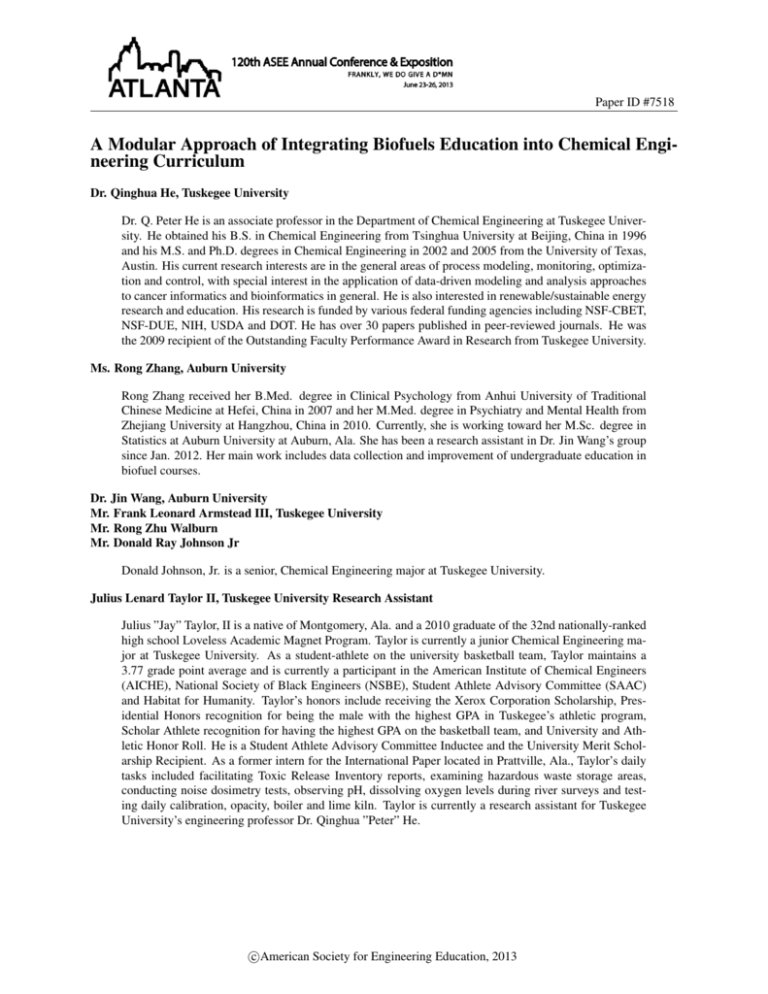
Paper ID #7518 A Modular Approach of Integrating Biofuels Education into Chemical Engineering Curriculum Dr. Qinghua He, Tuskegee University Dr. Q. Peter He is an associate professor in the Department of Chemical Engineering at Tuskegee University. He obtained his B.S. in Chemical Engineering from Tsinghua University at Beijing, China in 1996 and his M.S. and Ph.D. degrees in Chemical Engineering in 2002 and 2005 from the University of Texas, Austin. His current research interests are in the general areas of process modeling, monitoring, optimization and control, with special interest in the application of data-driven modeling and analysis approaches to cancer informatics and bioinformatics in general. He is also interested in renewable/sustainable energy research and education. His research is funded by various federal funding agencies including NSF-CBET, NSF-DUE, NIH, USDA and DOT. He has over 30 papers published in peer-reviewed journals. He was the 2009 recipient of the Outstanding Faculty Performance Award in Research from Tuskegee University. Ms. Rong Zhang, Auburn University Rong Zhang received her B.Med. degree in Clinical Psychology from Anhui University of Traditional Chinese Medicine at Hefei, China in 2007 and her M.Med. degree in Psychiatry and Mental Health from Zhejiang University at Hangzhou, China in 2010. Currently, she is working toward her M.Sc. degree in Statistics at Auburn University at Auburn, Ala. She has been a research assistant in Dr. Jin Wang’s group since Jan. 2012. Her main work includes data collection and improvement of undergraduate education in biofuel courses. Dr. Jin Wang, Auburn University Mr. Frank Leonard Armstead III, Tuskegee University Mr. Rong Zhu Walburn Mr. Donald Ray Johnson Jr Donald Johnson, Jr. is a senior, Chemical Engineering major at Tuskegee University. Julius Lenard Taylor II, Tuskegee University Research Assistant Julius ”Jay” Taylor, II is a native of Montgomery, Ala. and a 2010 graduate of the 32nd nationally-ranked high school Loveless Academic Magnet Program. Taylor is currently a junior Chemical Engineering major at Tuskegee University. As a student-athlete on the university basketball team, Taylor maintains a 3.77 grade point average and is currently a participant in the American Institute of Chemical Engineers (AICHE), National Society of Black Engineers (NSBE), Student Athlete Advisory Committee (SAAC) and Habitat for Humanity. Taylor’s honors include receiving the Xerox Corporation Scholarship, Presidential Honors recognition for being the male with the highest GPA in Tuskegee’s athletic program, Scholar Athlete recognition for having the highest GPA on the basketball team, and University and Athletic Honor Roll. He is a Student Athlete Advisory Committee Inductee and the University Merit Scholarship Recipient. As a former intern for the International Paper located in Prattville, Ala., Taylor’s daily tasks included facilitating Toxic Release Inventory reports, examining hazardous waste storage areas, conducting noise dosimetry tests, observing pH, dissolving oxygen levels during river surveys and testing daily calibration, opacity, boiler and lime kiln. Taylor is currently a research assistant for Tuskegee University’s engineering professor Dr. Qinghua ”Peter” He. c American Society for Engineering Education, 2013 A Modular Approach of Integrating Biofuel Education into Chemical Engineering Curriculum Q. Peter He1*, Rong Zhang2, Jin Wang2*, Frank Armstead III1, Rong Walburn2, Julius L. Taylor1 and Donald R. Johnson1 1 Department of Chemical Engineering Tuskegee University, Tuskegee, AL 36088 2 Department of Chemical Engineering Auburn University, Auburn, AL 36849 Abstract: In view of potential demand for skilled engineers and competent researchers in the biofuel field, we have identified a significant gap between advanced biofuel research and undergraduate biofuel education in engineering. To help bridge this gap, we have been creating educational materials that systematically integrate biofuels technology into undergraduate chemical engineering curriculum. The modular approach we proposed aims to address some of the major obstacles of introducing biofuel education into chemical engineering curricula. 1 Introduction It has been argued that advanced biofuel industry will have significant impact on U.S. economic recovery and its transition to a sustainable green economy. The U.S. National Academies have identified renewable energy as a national scientific strategy aimed at replacing the oil-based refinery and transitioning to a green economy. 1 In addition, as shown in a 2009 Biotechnology Industry Organization (BIO) study 2 (Figure 1), advanced biofuel industry will have significant impact on job creation and economic output in the near future. (a) (b) Figure 1 Impact of advanced biofuel industry on (a) job creation and (b) economic output. (Adapted from Ref. 2.) Therefore, there is a pressing and immediate national need of skilled engineers and competent researchers in the biofuel field. This need also presents an exciting yet challenging opportunity for the engineering educators to expand their mission to addressing biofuel production, and to contribute to this coming wave of change in the industry. 3 To address the education need for the emerging biofuel industry, in the past a few years many universities have introduced biofuel or renewable energy education by offering courses and introducing programs. 4,5,6,7,8,9,10,11 Table 1 lists some examples of such education efforts. Table 1 A short list of biofuel education programs Program name Institution / Department Offering type MBA and Certificate in Sustainable Business Bainbridge Graduate Institute MBA/Certificate in Sustainable Business; Florida Center for Renewable Chemicals and Fuels University of Florida / Institute of Food and Graduate Research Fellowships Agriculture Sciences The Center for Advanced BioEnergy Research UIUC / College of Agricultural, Consumer and Environmental Sciences Master of Science degree in bioenergy Alternative Energy Technology: Central Carolina Community College Biofuel Associate/Certificate in Biofuel Technology Sustainable Energy Initiative (SEI) Oregon State University / Chemical Engineering; Crop and Soil Science; Pilot projects for general public and high school students Biofuel Production Operations Certificate Program California State University - East bay / Continuing Education 6-month Certificate in Biofuel Production Operations Alternative Energy Programs Crowder College / Environmental Sciences Associate of Arts Degree Biodiesel Fuel Education Program University of Idaho / Biological & Agricultural Engineering Online short course for general public New York Center for Liquid Biofuel Morrisville State College / School of Agriculture and Natural Resources Create jobs in the agriculture sector As illustrated in Table 1, although many biofuel education programs have emerged recently, most of them target general non-engineering audience (such as agricultural or environmental majors, professionals in management, or general public). As a result, these efforts usually cover non-engineering aspects such as national policies, environmental impact, economic analysis, and terminologies. In other words, they do not provide the technical education that is required to train technically advanced engineers and researchers. Contrary to the lack of efforts in biofuel education for engineering undergraduates, there are many specialized research centers on biofuel technologies established in the past few years, especially in the chemical engineering field. Several examples of such research centers are listed in Table 2. These research centers mainly focus on advanced research and graduate/postgraduate education in engineering. 12,13,14,7 The research results generated from these centers, and other research groups and individual researchers, are usually published on scientific journals, which involve high level technical knowledge and complexities that only specialized scientists can understand. As a result, the available biofuel educational materials are quite dispersed and no single comprehensive literature source on biofuel processes exists that is suitable for engineering undergraduate education. Consequently, there is a significant gap between advanced biofuel research and undergraduate biofuel education in engineering. Table 2 A short list of large research centers funded by DOE, USDA and other agencies Center/Laboratory name Institution / Department Engines & Energy Conversion Laboratory (EECL) Colorado State Univ. Depart. of Mech. Eng. Center for BioEnergy Research and Dev. (CBERD) South Dakota School of Mines and Tech. (lead) Multi-Univ. / multidiscip. Biomass Energy Center Pennsylvania State Univ. / Multidiscip. (incl. Chem. Eng.) Office of Biobased Technologies (OBT) Michigan State Univ. / Multidiscip., (incl. Chem. Eng.) The Institute for Massachusetts Biofuel Research Univ. of Massachusetts Amherst / Multidiscip. (incl. Chem. Eng.) Biofuel Research Laboratory (BRL) Cornell Univ. / Depart. of Bio. & Env. Eng. Center for Direct Catalytic Conversion of Biomass to Biofuel Purdue Univ. / Multidiscip. (incl. Chem. Eng.) Catalysis Center for Energy Innovation (CCEI) Univ. of Delaware (lead) / Multi-univ.; Multidiscip. (led by Chem. Eng.) Combustion Energy Frontier Research Center Princeton Univ. (lead) / Multi-univ.; Multidiscip. (incl. Chem. Eng.) Bioenergy Systems Research Initiative (BSRI) Univ. of Georgia / Multidiscip. (incl. Chem. Engi.) Bioenergy Research Group (BERG) 2 Univ. of California, Davis / Multidiscip. (incl. Chem. Eng.) Approach/Method Among different engineering majors, chemical engineering is in a unique position to address this educational need. This is because most biofuel processes are chemical or biochemical processes, and all the underlying principles of biofuel processes, such as mass transfer, heat transfer and reaction engineering, are the same as those of traditional chemical or petrochemical processes. The only differences are that in biofuel processes different unit operations are arranged in different ways, and different raw materials are processed in biofuel plants. These similarities indicate a much easier transition from a traditional chemical engineer to a biofuel engineer compared with students from other engineering disciplines. Of course, biofuel processes have their unique characteristics and challenges. For example, in general biofuel processes are more complex than the traditional chemical or petrochemical processes, especially when lignocellulosic biomass is involved. This perhaps is the major reason for the lack of comprehensive yet simple enough material on biofuel processes that can be easily adopted into chemical engineering curricula. Although there are several excellent graduate textbooks on biofuel technology, undergraduates do not have adequate background knowledge to understand them. Due to the lack of appropriate educational materials, existing undergraduate biofuel educational efforts are often too fragmented to achieve critical mass for a visible impact on students’ understanding of the biofuel technology when they graduate. Over the years chemical engineering curricula have primarily focused on traditional chemical and petrochemical industry. In other words, most examples, homework problems, exams and design problems are developed based on the traditional chemical and petrochemical processes. As fundamental principles and concepts that involved in chemical processes (which are the same for biofuel processes) are introduced gradually and cumulatively throughout the chemical engineering curriculum, we believe that a better approach of teaching chemical engineering students biofuel technology is to adopt a piecemeal approach by creating a set of comprehensive yet flexible and apprehensible biofuel learning modules that spread across the entire chemical engineering curriculum. Specifically, instead of developing a separate senior course that is devoted to biofuel processes, we propose to break down the biofuel processes into small pieces such as unit operations, and each piece can be further broken down and simplified to illustrate different chemical engineering principles or concepts. For example, a gasifier is one of the units in a gasification process; it can be further simplified to illustrate mass balance, or energy balance. Or it can be further broken down to different zones (e.g., drying, pyrolysis, partial oxidation and combustion) to illustrate different heat effects, such as sensible heat and heat of reaction. In this way, lower level students will not be overwhelmed by the complexity of a biofuel process when they do not yet have all the background knowledge to comprehend it as a whole; while higher level students will feel much more comfortable in designing a complex biofuel plant because they have seen all the pieces in their lower level courses, maybe even multiple times. We believe this modular or piecemeal approach will result in better students learning outcome than the “single-course” approach. It should be noted that there are some efforts to include biofuels materials into textbooks by their authors; but they are not well documented or disseminated. It is also worth noting that one shortcoming of the proposed approach, compared to the approach of having a separate biofuels elective course, is that students who are not interested in biofuels will be required to learn the material and perform assignments. It is also desirable to include enough biofuel material in as many courses as possible to keep the topic fresh and persistent so that it would not get lost amongst the rest of the chemical engineering principles. Based on the modular or piecemeal approach, we have been developing a series of classroom learning modules that can be easily integrated into existing chemical engineering curricula. The key components of each module are: learning objectives, background information, example problems and solution, as well as homework and design problems. The modular and extensible nature of the learning material will enable instructors to easily select, share, expand, and modify the materials to fit students with various learning capabilities and career goals. Due to the complex nature of the biofuel processes and students’ limited exposure to biofuel technology, most students would feel incompetent in dealing with problems related to biofuel. To help students overcome this barrier, we have also been creating a series of web modules to accompany the classroom modules by exploiting two instructional strategies: computer-assisted instruction and visual learning. Computer-assisted instruction is an innovative instructional strategy that has been receiving increasing attention in engineering education. 16 It has been shown that computer-assisted instruction provides students with rapid inquiry-based learning experiences, allowing students to proceed at their own pace and within their own schedule. 17,18,19 Visual learning – the use of graphics, images, and animations to enable and enhance learning – has been shown to be effective in exploiting students’ visual senses to engage students in active learning, support traditional lessons, and make their learning experience stronger and deeper. 20,21,22,23,24,25,26 This methodology also has the potential to increase the number of students in science, technology, engineering, and math (STEM) fields, especially of women and minority students. 24 The key components of the web modules include: glossary, process introduction, process flow diagram, captured and animated process video clips, visual encyclopedia of equipment, reference shelf, solved problems. While classroom modules focus on the fundamental aspects of biofuel technology that are more suited to the current undergraduate chemical engineering curriculum, the on-line web modules will provide more background knowledge and other resources to assist students with understanding classroom modules. In this way, students will not only be exposed to biofuel technology, but also get fresh stimulus in learning chemical engineering principles. Besides assisting students with classroom modules, another intended goal of the web modules is to use recently emerged effective teaching strategies combined with the “hot” topic of biofuel to stimulate students’ interest in learning traditional chemical engineering principles. 3 Results 3.1 Classroom modules We intended to develop eight classroom modules: four for Chemical Engineering Thermodynamics class and four for Chemical Reaction Engineering class. Specifically, the following four classroom modules will be developed for Chemical Engineering Thermodynamics: Module 1: Mass and Energy Balance for Batch and Continuous Gasification Processes Module 2: Equations of State for Biofuel Processes Module 3: Heat Effects in Biofuel Processes Module 4: Thermodynamic Analysis of Biofuel Processes The following four classroom modules will be developed for Chemical Reaction Engineering: Module 1: Design Equations for Batch and Continuous Gasifiers. Module 2: Rate Laws and Stoichiometry for Various Biofuel Reactions Module 3: Design of CSTRs and Packed Bed Reactors (PBRs) for Biofuel Processes Module 4: Multiple Reactions in Biofuel Processes At the time this paper is being written, we have finished the development of three thermodynamics modules and two reaction engineering modules. An abridged version of a developed classroom module is provided in Figure 3 as an example. As can be seen from Figure 3, each classroom module is linked to one chapter or some sections of the most commonly used textbooks, as indicated in the “Associated Sections in Selected Textbooks” section of each module. In this way, there is no textbook or even the course syllabus change or addition needed, making adoption extremely easy – the instructor can straightforwardly replace or supplement some of the textbook examples and homework problems with the examples and problems provided by the classroom module. To give students a big picture of the module, the “Background Information” section provides students with motivations, process introduction, and fundamental principles and concepts involved, etc. In addition, the “Web Module Links” point students to relevant web modules to promote active learning and student engagement. Finally, for some modules, one or more comprehensive, open-ended design problems will be provided. 3.2 Web modules For the web modules, we have been developing a glossary, collections of commonly used equipments, different biofuel processes, animated video clips, and a reference list. Specifically, we have developed a comprehensive glossary of frequently used acronyms and definitions of various specialized terms used in the biofuel industry with hundreds of entries, which provides explanation to common terminologies in biofuel technology. Chemistry and chemical engineering details are included to make them more technical and job-oriented. At the time this paper is being written, we have included more than five hundred terms. This glossary serves as an essential resource for students with little or no biofuel background. We also have developed a collection of common equipment used in biofuel processes, namely Visual Encyclopedia of Equipment, which includes a wealth of photographs, drawings, videos, and descriptions of different equipments used in different biofuel processes, such as gasifiers, pyrolyzers and reformers. This resource also serves as a tool to build up students’ biofuel background. So far we have developed more than 30 equipment modules. Due to limited space, we can only provide two snap shots as shown in Figure 4. Besides individual equipment, we have developed the following seven web modules for different biofuel processes: 1. Thermochemical conversion of biomass 2. Fischer–Tropsch process 3. Gasification Module 3: Heat Effects in Biofuel Processes 【Associated Sections in Selected Textbooks】 • Chemical Engineering Thermodynamics (24) Sec. 4.1~4.7 • Chemical, Biochemical and Engineering Thermodynamics (25) Sec. 4.4, 6.4, 7.7, 8.5 【Module Learning Objectives】 • • • • Describe and differentiate different heat effects Identify the involved heat effects for a given process Compute the generated heat or heat transfer for a given process Design heat transfer equipments by applying knowledge on different heat effects 【Background Information】 Heat transfer is a common operation in the biofuel industry and heat effects are involved in almost all unit operations of a biofuel plant. Consider, for example, the biomass gasification. Dry biomass burns at higher temperatures and thermal efficiencies than wet biomass… In this module, we apply thermodynamics to the evaluation of most of the heat effects that accompany physical and chemical operations in a gasification process. 【Example Problems】 Totally 12 example problems are provided to illustrate the calculation of different heat effects: • • • • • • • Sensible heat effects: Examples 1 & 2 Latent heat effects: Example 3 Standard heat of reaction: Examples 4 & 5 Standard heat of formation: Example 6 Standard heat of combustion: Example 7 Temperature dependence of Ho: Examples 8 & 9 Heat effects of industrial reactions: Examples 10-12 Example 1: Sensible heat effects In an updraft gasifier (see Figure 2), moist biomass fuel is fed at the top and descends though gases rising through the reactor. Various physical and chemical processes occur in the gasifier, see “Updraft Gasification” on the web module for details. In the drying zone of an updraft steam-only gasifier, the gas mixture from the lower zones (oxidation, partial oxidation and pyrolysis) makes contact with biomass from the feeding chute. During the process, free moisture and cellbound water in the biomass are removed by evaporation. The up-flowing gas mixture consists of 29% H2, 34% CO, 17% CO2, 15% CH4 and 5% H2O, all in mol %. If the heat transfer in this process is 108 kJ/s, the up-flowing gas mixture enters the heating zone at a steady rate of 350… mol/s at 800oC, what is the temperature of the gas mixture leaving the heating zone? Solution: (omitted) Figure 2 Schematic diagram of an updraft gasifier 【Homework Problems】 Totally 10 homework problems are provided. (Solutions will be provided to instructors upon request.) HW #2 (): A gas mixture of CO, CO2 and H2 at 500oC from a gasifier is fed to a reactor to produce methanol. The following methanol synthesis reactions occur in the reactor: CO (g) + 2H2 (g) → CH3OH (g) CO2 (g) + 3H2 (g) → CH3OH (g) + H2O (g) The product stream leaves the reactor at 850oC. Its composition (mole fractions) is: Determine the quantity of heat added to (or removed from) the reactor per mole of product gas. … 【Design Problems】 [A biomass rotary dryer design problem is omitted due to space limitation.] Figure 3 An abridged version of the Module 3 for the thermodynamics class 4. Fermentation 5. Thermochemical conversion of biomass 6. Fischer–Tropsch process 7. Gasification 8. Fermentation 9. Pyrolysis 10. Combustion 11. Liquefaction Each module includes a technical introduction of the process, the process flow diagram, equipments or reactors, related videos and glossary terms, and references. Compared to a classroom module, which extracts the same fundamental concepts, such as heat of reactions, from different processes, a process web module is process oriented. In other words, it provides students a complete or holistic description of a process that involves different fundamental principles and concepts, such as mass transfer, heat transfer and phase equilibria. Due to the large amount of materials contained in each module, we omitted the snapshot here. To enhance students’ visual learning, we have also developed the following nine animated process video clips. 1. 2. 3. 4. 5. 6. 7. 8. 9. Gas to Liquid process Biomass to Liquid process Coal to Liquid process Four types of Fischer-Tropsch reactors Five types of Gasifier Process of Fermentation Process of Pyrolysis Process of Combustion Process of Liquefaction The animated videos were created based on process flow diagrams, equipment illustrations, and cutaway drawings. A video clip provides a vivid description of how a process operates, including the flow of material streams, details of the reactions, energy exchanges, etc. Compared to verbal descriptions, these videos provide students a more intuitive and dynamic view of the process, which could significantly improve students’ understanding of a process. All videos are accompanied with narrations and are shared on YouTube. Collectively, they’ve been viewed more than 1,000 times in the past two months. In addition, we have also included more than two dozen biofuel related videos developed by other organizations. Finally, we have compiled a comprehensive reference list, which students can find additional information and use for further study. The reference list includes hundreds of books, journal articles and website links related to biofuel technology. (a) (b) Figure 4 Snap shots of Visual Encyclopedia of Equipment module: (a) an incomplete list; (b) part of the Hopper Feeder page (more figures and videos were cut off). All the classroom and web modules are hosted on our recently established website (www.BiofuelsAcademy.org), which is dedicated to chemical engineering undergraduate biofuel education. 4 Conclusions This work was motivated by the potential need of a technologically advanced workforce and innovative researchers in the biofuel field. To address this need, we first identified the gap between advanced biofuel research and undergraduate biofuel education in engineering. We then introduced a modular approach to bridge this gap by creating educational materials that systematically integrate biofuel education into chemical engineering curriculum. Specifically, we have created a set of classroom modules by simplifying and decomposing complex biofuels processes. Each classroom module focuses on one aspect of fundamental chemical engineering principles, e.g., one chapter of a typical textbook, making it easy for wide adoption. To address different learning styles and enhance students’ active engagement through computer-assisted instruction and visual learning, we have also created a series of web modules to accompany the classroom modules. We expect the unique combination of classroom modules with web modules will effectively enhance students’ understanding of chemical engineering principles, as well as significantly increase students’ exposure to biofuel technology. We expect wide adoption of our learning materials among chemical engineering educators because our approach can effectively address the following three major obstacles of introducing biofuel education into chemical engineering curricula: (1) there is a lack of learning materials that are appropriate for undergraduate; (2) not all academic programs will be able to accommodate additional course(s) with all other programmatic requirements currently in place; and (3) any changes to the curriculum that requires significant effort from faculty or staff would be difficult to sell and adopted widely. In the proposed framework, the classroom modules serve as the supplementary materials to existing chemical engineering textbooks. In other words, our primary goal is still for students to understand and apply chemical engineering principles. Introducing biofuels education is the secondary goal, which exposes students to contemporary issues and industrial/national needs. Therefore, the basic concepts and fundamental principles are still from the textbooks and are taught in the same way as in a traditional chemical engineering class. The examples and homework problems provided in the developed biofuel modules can be used to replace/supplement some of the textbook examples and homework problems. The advantages of this modular approach that makes it easy for adoption are summarized in the following table from both instructors’ and students’ points of view. Table 3 Advantages of the proposed modular framework for biofuel education Features Benefits to instructors Benefits to students Compatibility No textbook/syllabus change or addition Reduces psychological barrier Modularity Independent modules/problems enable free choice of use Learning of one module will not negatively affect their learning of others Flexibility Easy to modify/add example/homework Comprehensive problem collection Ample examples/homework to choose from Ample examples to learn and ample homework to exercise on Solution availability Solutions to examples/homework are provided– no extra burden for instructors Example solutions help develop strong problem solving strategies and skills Web modules Reduce classroom time spent on modules and minimize disruption to existing curriculum because great details are provided in the corresponding web modules Provide additional resource and assistance that enhance student learning; encourage self-learning; address different learning styles 5 Future work We want to acknowledge that we do not have data to validate the effectiveness of the proposed approach, including student reception of the material, meeting learning objectives, etc.. We plan to integrate the biofuel learning modules, developed or to be developed, into two chemical engineering core courses: thermodynamics and chemical reaction engineering. We will then evaluate student learning outcomes and hope to contribute to the growing literature in understanding what works and what doesn’t in engineering education. Once the learning modules are refined, we will explore several avenues for wide dissemination, including continuous update and improvement of our website, contacting other educators/professors, journal papers, presentations/posters at conferences, etc. 6 Acknowledgement Financial supports from the National Science Foundation under Grant No. 1044300 and the U.S. Department of Agriculture through the Southeast Partnership for Integrated Biomass Supply System (IBSS) are greatly appreciated. References: 1. The National Academies. Rising Above the Gathering Storm: Energizing and Employing America for a Brighter Economic Future; The National Academies Press: Washington, D.C., 2007. 2. Biotechnology Industry Organization. BIO. http://bio.org/news/pressreleases/newsitem.asp?id=2009_0225_02&p=yes (accessed Feb 10, 2010). 3. Rosentrater, K. A.; Balamuralikrishna, R. The growing importance of emerging biobased industries to engineering and technology. The International Journal of Applied Management and Technology 2007, 16-33. 4. MIT Professional Education. http://web.mit.edu/professional/short-programs/courses/biofuels_biomass.html. 5. Iowa Central Community College. Biofuels Technology Program. http://www.iowacentral.edu/mathscience/science/programs/biofuels/index.asp. 6. University of Colorado at Boulder. The Renewable and Sustainable Energy Institute (RASEI). http://rasei.colorado.edu/index.php?id=1&page=Home. 7. University of Connecticut. UConn Biofuels Consortium. http://biodiesel.engr.uconn.edu/index.html (accessed 2010). 8. University of Kentucky Center for Applied Energy Research. Biomass to Energy: An Overiew Short Course. http://www.caer.uky.edu/events/biofuels2010.html. 9. University of Louisiana at Lafayette. Department of Renewable Resources. http://rres.louisiana.edu/Leon.htm. 10. University of Wyoming. The Department of Renewable Resources. http://www.uwyo.edu/renewable/. 11. Varde, K. S. Undergraduate Research Experience in Energy Conversion and Alternate Energy Systems. 9th International Conference on Engineering Education, San Juan, PR, 2006; pp M5K-10-13. 12. The University of Massachusetts Amherst. The Institute for Massachusetts Biofuel Research. http://www.ecs.umass.edu/timbr/index.html. 13. UC BERKELEY. ENERGY BIOSCIENCES INSTITUTE. http://www.energybiosciencesinstitute.org/ (accessed 2010). 14. University of California, Davis. Bioenergy Research Center at UC Davis. http://bioenergy.ucdavis.edu/index.php (accessed 2010). 15. Vogels, J. The Carbo-V® gasification process for the production of syngas. International Seminar on Gasification andMethanation, Gothenburg, Sweden, 2007. 16. Abu-Hajar, A.; Holden, M. INTERACTIVE COMPUTER-BASED VIRTUAL CLASSROOM FOR ENGINEERING COURSES. American Society for Engineering Education, Honolulu, Hawaii, 2007; p 1808. 17. Fang, N.; Stewardson, G. A.; Lubke, M. M. Enhancing Student Learning of an Undergraduate Manufacturing Course with Computer Simulations. Int. J. Engng Ed. 2008, 558-566. 18. MIT. Open Courseware. http://ocw.mit.edu/index.html. 19. Hogan, K., Pressley, M., Eds. Scaffolding Student Learning: Instructional Approaches & Issues. Advances in Teaching and Learning Series; Brookline Books: Cambridge, MA, 1997. 20. Laws, P. Using digital video analysis in introductory mechanics projects. The Physics Teacher 1998, 36 (5), 282-287. 21. Konyalioglu, S.; Konyalioglu, A. C.; S., I. A.; A., I. The Role of Visualization Approach on Student’s Conceptual Learning. Interntational Journal for Mathematics Teaching and Learning 2005. 22. Blanchard, P. Easy Animations. In Invention and Impact: Building Excellence in Undergraduate Science, Technology, Engineering, and Mathematics (STEM) Education; AAAS Press, 2005; pp 147-149. 23. Konyalioglu, A. C. An evaluation from studennts' perspective on visualization approach used in linear algebra instructions. World Applied Science Journal 2009, 1046-1052. 24. McGrath, M. B.; Brown, J. R. Visual learning for science and engineering. IEEE Computer Graphics and Applications 2005, 56-63. 25. Bransford, J. D., Brown, A. L., Cocking, R. R., Eds. How People Learn: Brain, Mind, Experience, and School; National Academies Press: Washington, DC, 1999. 26. Frankel, F. Translating Science into Pictures: A Powerful Learning Tool. In Invention and Impact: Building Excellence in Undergraduate Science, Technology, Engineering, and Mathematics (STEM) Education; AAAS Press, 2005; pp 155-158. 27. Smith, J. M.; Van Ness, H. C.; Abbott, M. M. Introduction to Chemical Engineering Thermodynamics, 7th ed.; McGraw Hill: New York, 2005. 28. Sandler, S. I. Chemical, Biochemical, and Engineering Thermodynamics, 4th ed.; John Wiley & Sons, Inc.: New York, 2006. 29. Clark, J. H., Deswarte, F. E. I., Eds. Introduction to Chemicals from Biomass (Wiley Series in Renewable Resource); Wiley: West Sussex, 2008. 30. Demirbas, A. Biofuels: Securing the Planets Future Energy Needs; Springer: London, 2009. 31. Drapcho, C.; Nghiem, J.; Walker, T. Biofuels Engineering Process Technology; McGraw Hill: New York, 2008. 32. Soetaert, W., Vandamme, E., Eds. Biofuels (Wiley Series in Renewable Resource); Wiley: West Sussex, 2009.
